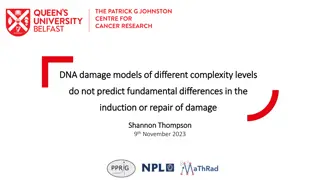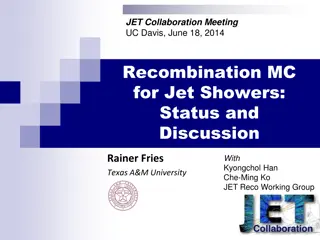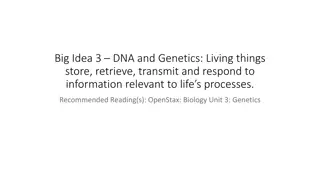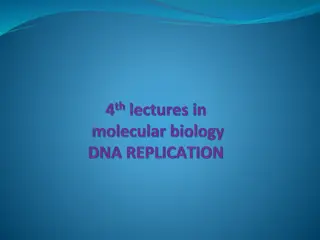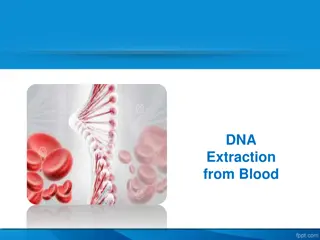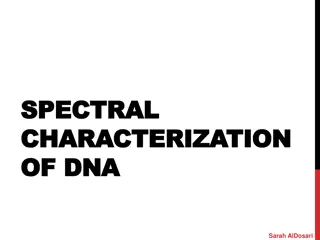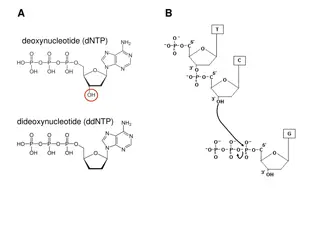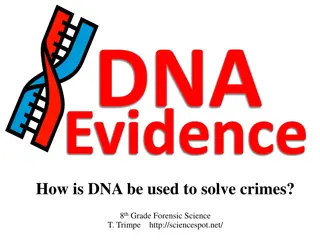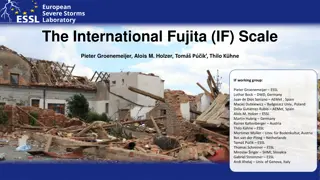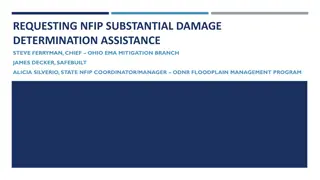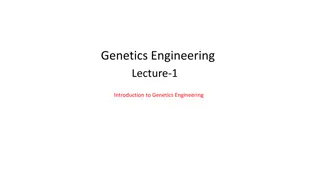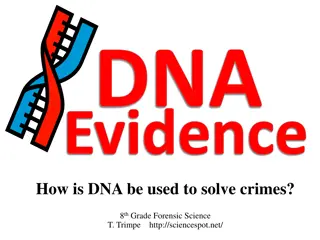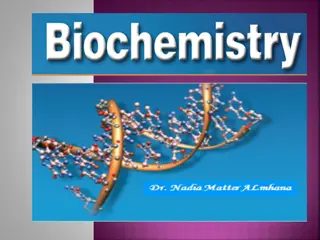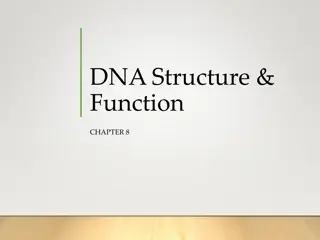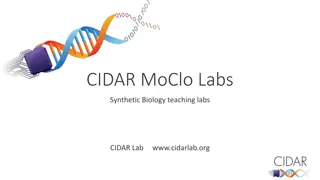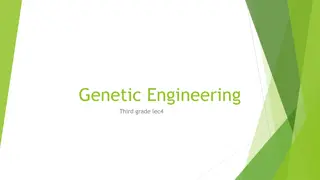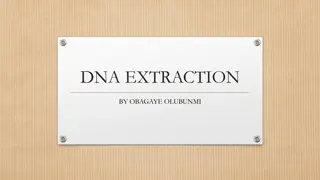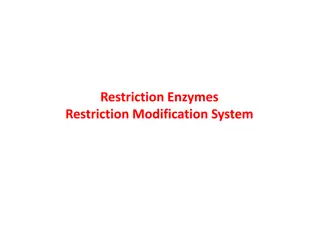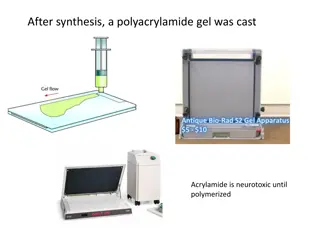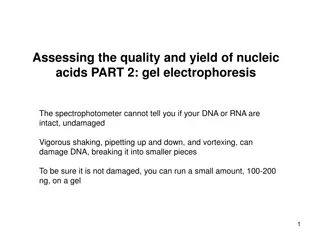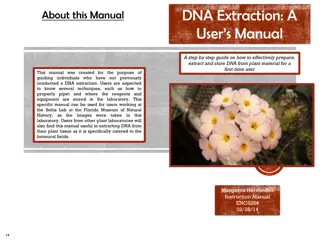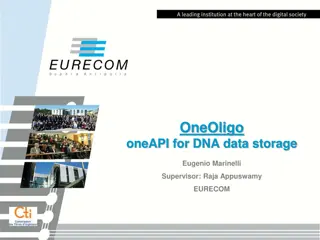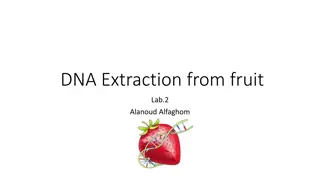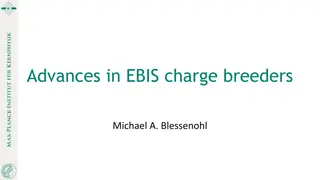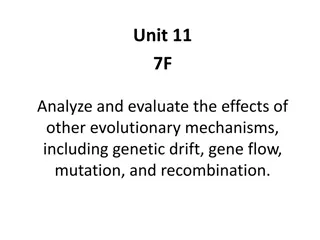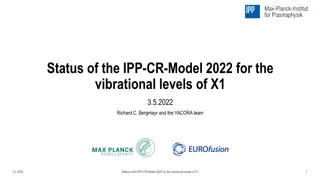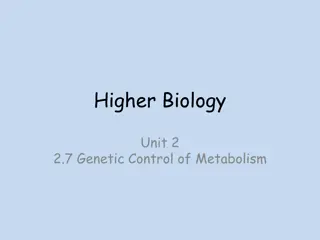Understanding Mutagenesis, DNA Damage, Repair, and Recombination
Mutations in DNA, caused by various factors such as radiation and chemical mutagens, can lead to permanent changes in the genetic sequence. Repair mechanisms like direct reversal, excision repair, and trans-lesion DNA synthesis play crucial roles in maintaining DNA integrity and accuracy during replication.
Download Presentation

Please find below an Image/Link to download the presentation.
The content on the website is provided AS IS for your information and personal use only. It may not be sold, licensed, or shared on other websites without obtaining consent from the author. Download presentation by click this link. If you encounter any issues during the download, it is possible that the publisher has removed the file from their server.
E N D
Presentation Transcript
MUTAGENESIS DNA DAMAGE DNA REPAIR RECOMBINATION
Mutations are heritable permanent changes in the base sequence of DNA. Point mutations may be transitions (e.g. GC AT) or transversions (e.g. GC TA). Deletionsand insertions involve the loss or addition of bases and can cause frameshifts in reading the genetic code. Silent mutations have no phenotypic effect, while missense and nonsense mutations change the amino acid sequence of the encoded protein.
The high accuracy of DNA replication (one error per 1010bases incorporated) depends on a combination of proper base pairing of template strand and incoming nucleotide in the active site of the DNA polymerase, proofreading of the incorporated base by 3 5 exonucleaseand mismatch repair.
Ionizing (e.g. X-and -rays) and nonionizing (e.g. UV) radiation produce a variety of DNA lesions. Pyrimidinedimersare the commonest product of UV irradiation.
Base analogs can mispairduring DNA replication to cause mutations. Nitrous acid deaminatescytosine and adenine. Alkylatingand arylatingagents generate a variety of adducts that can block transcription and replication and cause mutations by direct or, more commonly, indirect mutagenesis. Most chemical mutagens are carcinogenic.
If a base analog or modified base whose base pairing properties are different from the parent base is not removed by a DNA repair mechanism before passage of a replication fork, then an incorrect base will be incorporated. A second round of replication fixes the mutation permanently in the DNA.
Most lesions in DNA are repaired by error- free direct reversal or excision repair mechanisms before passage of a replication fork. If this is not possible, an error-prone form of trans-lesion DNA synthesis may take place involving specialized DNA polymerases and one or more incorrect bases become incorporated opposite the lesion.
The chemical reactivity of DNA with exogenous chemicals or radiation can give rise to changes in its chemical or physical structure. These may block replication or transcription and so be lethal, or they may generate mutations through direct or indirect mutagenesis. The chemical instability of DNA can generate spontaneous lesions such as deaminationand depurination.
Reactive oxygen species such as superoxide and hydroxyl radicals produce a variety of lesions including 8-oxoguanine and 5- formyluracil. Such damage occurs spontaneously but is increased by some exogenous agents including -rays.
Alkylation Electrophilic alkylating agents such as methylmethane sulfonate and ethylnitrosourea can modify nucleotides in a variety of positions. Most lesions are indirectly mutagenic, but O6-alkylguanine is directly mutagenic.
Bulky adducts Bulky lesions such as pyrimidinedimersand arylatingagent adducts distort the double helix and cause localized denaturation. This disrupts the normal functioning of the DNA.
Photoreactivation Cleavage of the cyclobutane ring of pyrimidine dimers by DNA photolyases restores the original DNA structure. Photolyases have chromophores which absorb blue light to provide energy for the reaction.
Alkyltransferase An inducible protein specifically removes an alkyl group from the O6position of guanine and transfers it to itself, causing inactivation of the protein.
Excision repair In nucleotide excision repair, an endonuclease makes nicks on either side of the lesion, which is then removed to leave a gap. This gap is filled by a DNA polymerase, and DNA ligasemakes the final phosphodiester bond. In base excision repair, the lesion is removed by a specific DNA glycosylase. The resulting AP site is cleaved and expanded to a gap by an AP endonucleaseplus exonuclease. Thereafter, the process is like nucleotide excision repair.
Mismatch repair Replication errors which escape proofreading have a mismatch in the daughter strand. Hemimethylationof the DNA after replication allows the daughter strand to be distinguished from the parental strand. The mismatched base is removed from the daughter strand by an excision repair mechanism.
Hereditary repair defects Mutations in excision repair genes or a trans- lesion DNA polymerase cause different forms of xeroderma pigmentosum, a sun-sensitive cancer-prone disorder. Excision repair is also defective in Cockayne syndrome.
Also known as general, this process involves the exchange of recombination homologous regions between two DNA molecules (during meiosis in diploid eukaryotes) Haploid bacteria perform recombination, for example between the replicated portions of a partially duplicated DNA or between the chromosomal DNA and acquired foreign DNA such as plasmids or phages.
Homologous recombination is also important for DNA repair. When a replication fork encounters an unrepaired, noncodinglesion it can skip the damaged section of DNA and re-initiate on the other side, leaving a daughter strand gap. This gap can be filled by replacing it with the corresponding section from the parental sister strand by recombination. The resulting gap in the parental sister strand can be filled easily since it is not opposite a lesion. The original lesion can be removed later by normal excision repair. This mechanism has also been called post- replication repair.
This involves the exchange of nonhomologous but specific pieces of DNA and is mediated by proteins that recognize specific DNA sequences. It does not require RecA or ssDNA. eg. Bacteriophage In eukaryotes, site-specific recombination is responsible for the generation of antibody diversity.
Transposons are small DNA sequences that can move to virtually any position in a cells genome. it requires no homology between sequences nor is it site-specific. the E. coli IS elements or insertion sequences, are 1 2 kb in length and comprise a transposase gene flanked by short (~20 bp) inverted terminal repeats (identical sequences but with opposite orientation). The transposase makes a staggered cut in the chromosomal DNA and, in a replicative process, a copy of the transposon inserts at the target site The gaps are filled and sealed by DNA polymerase and DNA ligase
The gene into which the transposoninserts is usually inactivated, and genes between two copies of a transposoncan be deleted by recombination between them.
In addition to a transposase, the Tn transposon series carry other genes, including one for -lactamase, which confers penicillin resistance on the organism Many eukaryotic transposons have a structure similar to retroviral genomes The dispersed repetitive sequences found in higher eukaryotic DNA (e.g. LINES and SINES) probably spread through the genome by transposition







